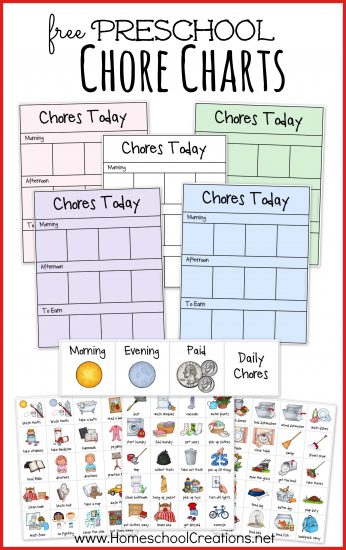
Younger children can have a hard time reading from a chore list. Picture cards can be a huge help at the preschool age so kids can see what needs to be done each day – and actually work on their daily chores (grins).
Our kids have learned personal and financial responsibility in the process as they are taught how to save, give, and put money in their wallet for spending too!
While I’ve shared a version of our preschool chore charts in the past, I recently found some wonderful clip art that included a few bonus chores and was also cute – a win-win!
These charts have been some of the most popular downloads here and I’ve received many emails with requests for extra chores, so I put together a FREE Preschool Chore Chart printable especially for my email subscribers – yay!!
Are you already an email subscriber? Please go to this private page and enter the NEW password. You can find the password in your most current email at the very bottom. Become a subscriber HERE and receive instant access.
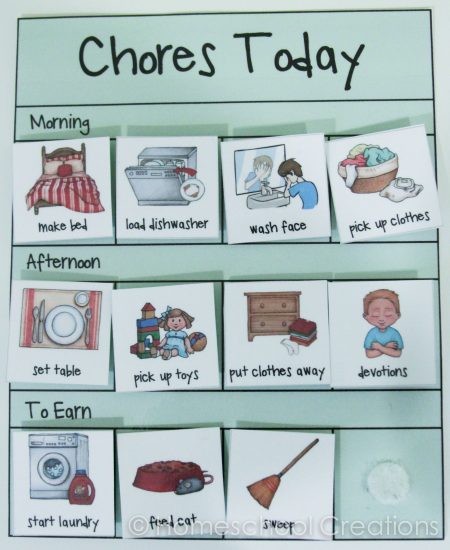
When Kaleb was younger, this is the chore chart that we used for him and it worked wonderfully. (And to tell you the truth – he still prefers this visual chore chart over our chore charts for the older kids!) We broke his chore chart into three parts: morning chores, afternoon chores, and chores that he could earn money on.
He earned minimal money, but our point in paying for a few chores is to help our kids understand the concept of giving, saving, and spending. Pennies were excitement to our kids at that age (they think they are rich!), so it was a great way to learn.
The chore charts and chore cards can be printed off on to cardstock and laminated to make them sturdier. Place velcro dots in the center of each square and on the back of each chore cards to make them stick to the chore chart. (See below for additional ways to use the printables).
Using the Chore Charts
Each morning I added chore cards to his chart. When a chore was completed, he would remove it and put it in a little box nearby. Chores he completed to earn money were tracked on the back of the chart by writing with a Sharpie (the Sharpie comes off easily with nail polish remover or you can use a vis-à-vis marker as well).
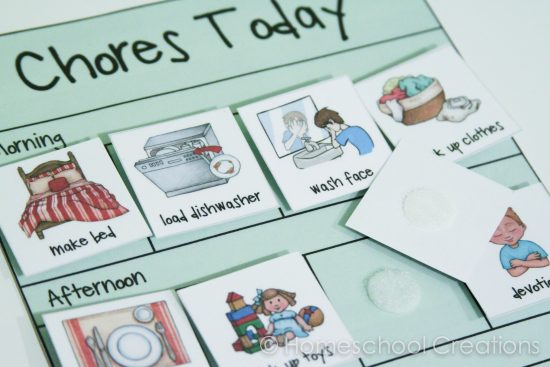
The cards are the same size as my workbox activity cards, so if you want to mix and match those cards with this grid, they will work together.
Daily Chores for Preschool
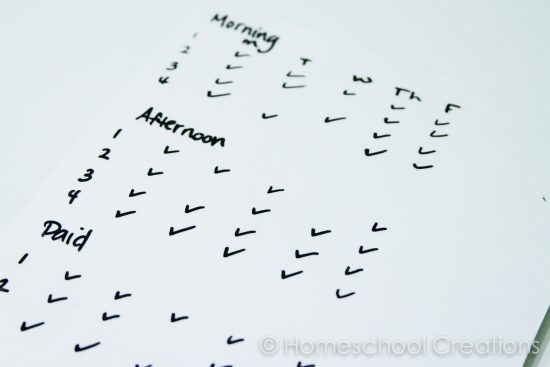
We kept it pretty simple for our preschool chores. Above is a peek at some of the things that we had on Kaleb’s chore chart. Many of the chores rotated throughout the week, but there were several that were consistent on a daily basis.
- Daily chores: make bed, clean room, brush teeth, pick-up clothes, pick up shoes/hang up jacket, set table, wash table, devotions.
- Extra {paid} chores: trash, vacuum, laundry, wash windows, dust, sweep, water plants, weed garden.
If you need help coming up with chore ideas, here is a great list from Money Saving Mom to help you out.
Tips for an Effective Chore System
- Make sure chores are age appropriate. Children can be taught to complete household tasks, but there are some things that are definitely more difficult for younger children to work on vs. older children. Be sure that the chores you are asking your very young children are appropriate for their age. Younger children can help sweep, push a vacuum cleaner, pick up toys, match socks, etc… but may not be ready for other chores. Just because a chore card is listed, doesn’t mean it has to be used. (grins)
- Keep the chore charts handy – and where they can be seen. Hang your charts somewhere where they will be seen daily – the front of the fridge, near the bedroom door. Where ever they are, be sure to keep them handy so both you and your child remember to work on them.
- Walk through how the charts work with your kids. Be sure to show your kids how the chore chart will work each day. Do they need to check in with you when they are done and have you go over their work? Have the system in place
- Know what works best as incentives for your kids. Some children may work for treats from the Dollar Tree, while others may work for small monetary prizes. The incentives are up to you – and you know what works best for your children!
- Be consistent in payout of incentives. It is so easy to let things slide, but if you are working with your kids in understanding that no work = no pay, remember that it goes the same the other way too. When you work, your boss pays you, so pick a ‘payday’ and take care of it each week or whenever you set up your payday.
Washing dishes is always fun….
And making beds…
Additional Ways to Use the Chore Charts
Rather than using a large chart, there are a few alternate ways that the chore charts can be used.
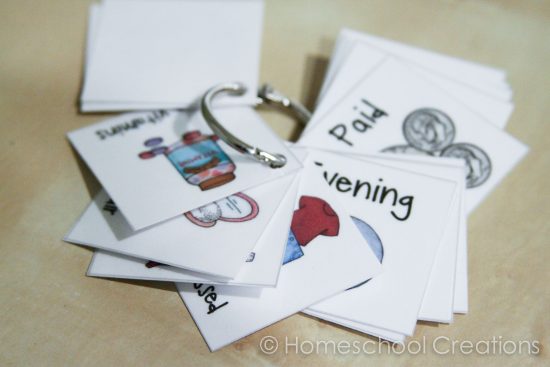
- Use a jump ring: The cards can be printed off on cardstock, laminated, and then put onto a jump ring so children can carry them around while working. The printable includes a few alternative cards that can be placed on the jump ring as well: morning chores, afternoon chores, paid, chores, etc…
- Use magnetic sheets: If you have a magnetic refrigerator, consider printing the chore cards off onto magnetic sheets, cutting them out, and placing chores on your fridge. Store finished or extra chores in a magnetic pencil bin nearby. We have friends that do this and it is so handy!
Download the Preschool Chore Charts
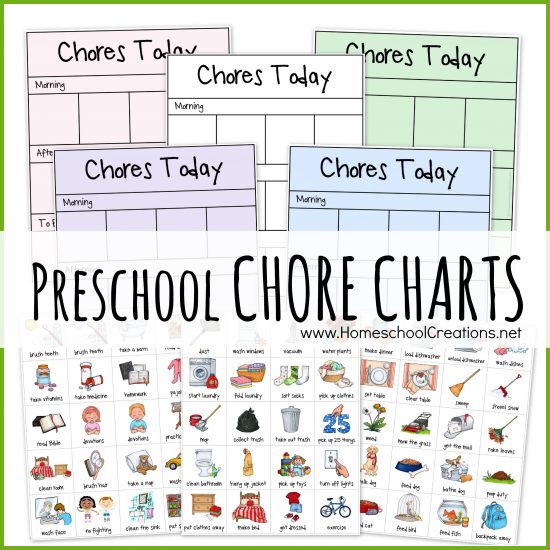
The chore chart file has five different colored charts: blue, green, pink, purple and white {so you can print on colored cardstock if you would like} and also includes chore cards. If you have any questions, feel free to ask. :)
If you aren’t on the paid chore bandwagon, there is a white chart with an alternate text of morning, afternoon, and evening.
This is a FREE download for subscribers – and it is really easy to subscribe by simply clicking HERE, or by entering your email in the box at the bottom of this post.

After you subscribe by email, you will receive a confirmation. Once you confirm your subscription, you will be redirected to a page with a link, password, and directions to get your FREEBIE!! You can always email me if you have any questions and I’d be happy to help you out.
In case you missed them before, you can also download a copy of our Chore Chart Printables for our older kids and see how we’re implementing that system in our house. There may also be extra cards for you to use in the workbox activity cards.
Hope this helps you out and feel free to ask any questions below!
Chore Chart Supplies
The following products are ones that we use and recommend for putting your chore charts together – the Scotch laminator ROCKS!! I’ve had mine for years and it is still going!



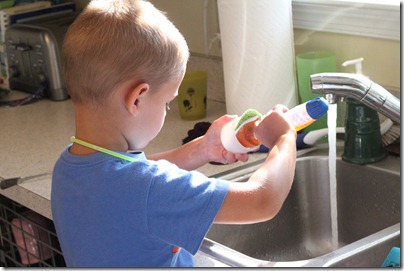
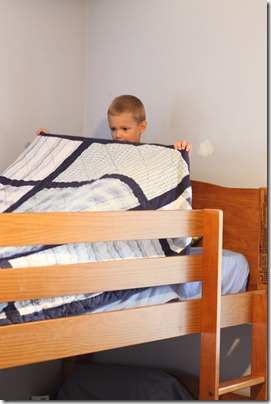
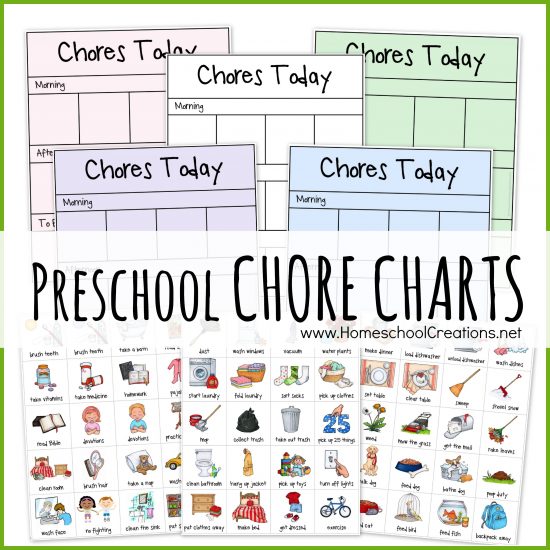
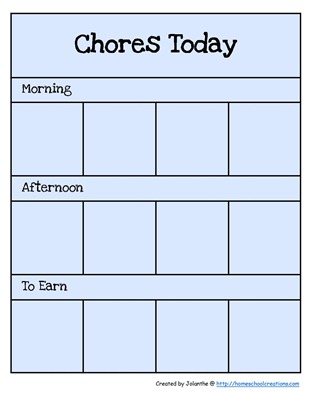
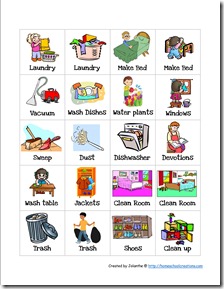
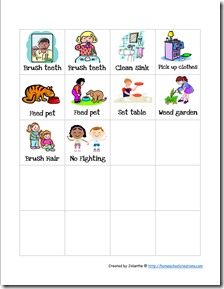
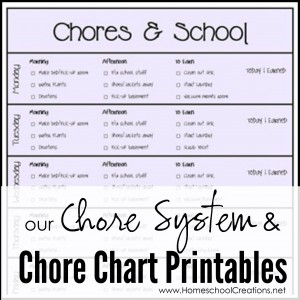
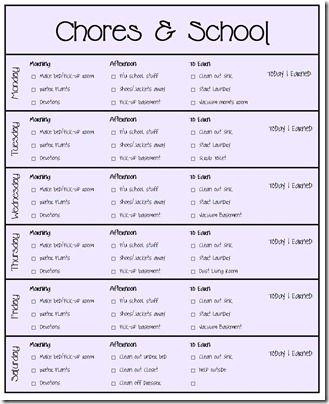

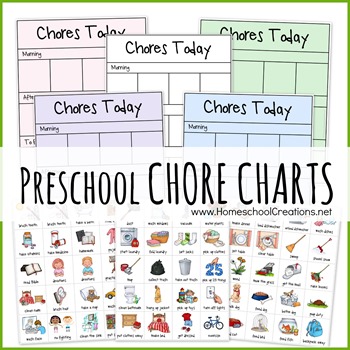




 The printables shared on this site are FREE of charge unless otherwise noted, and you are welcome to download them for your personal and/or classroom use only. However, free or purchased printables are NOT to be reproduced, hosted, sold, shared, or stored on any other website or electronic retrieval system (such as Scribd or Google docs). My printables are copyright protected and I appreciate your help in keeping them that way.
If you download and use some of my printables and then blog about them, please provide a link back to my blog and let me know - I'd love to see how you are using them! Please be sure to link to the blog post or web page and not directly to the file itself. Thank you!
The printables shared on this site are FREE of charge unless otherwise noted, and you are welcome to download them for your personal and/or classroom use only. However, free or purchased printables are NOT to be reproduced, hosted, sold, shared, or stored on any other website or electronic retrieval system (such as Scribd or Google docs). My printables are copyright protected and I appreciate your help in keeping them that way.
If you download and use some of my printables and then blog about them, please provide a link back to my blog and let me know - I'd love to see how you are using them! Please be sure to link to the blog post or web page and not directly to the file itself. Thank you!